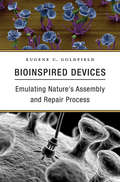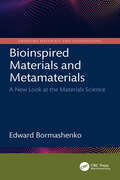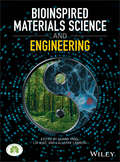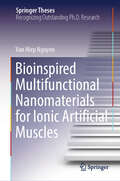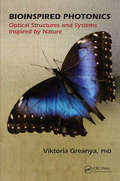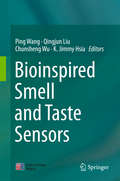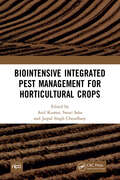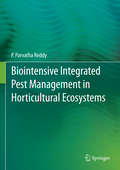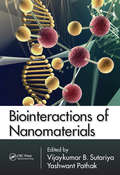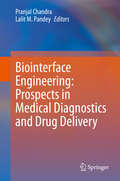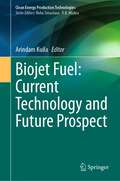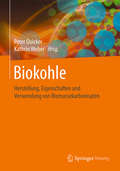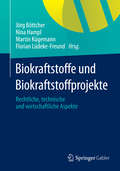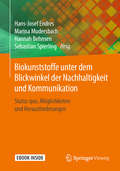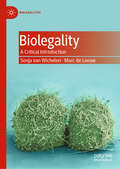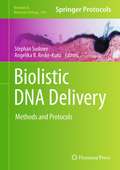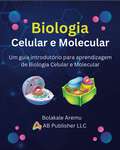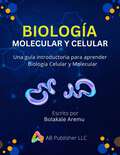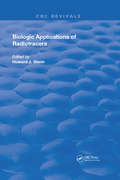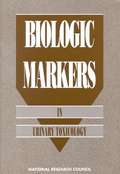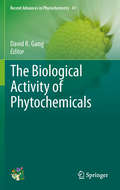- Table View
- List View
Bioinspired Devices: Emulating Nature’s Assembly and Repair Process
by Eugene C. GoldfieldEugene Goldfield lays out principles of engineering found in the natural world, with a focus on how components of coordinated structures organize themselves into autonomous functional systems. This self-organizing capacity is one of many qualities which can be harnessed to design technologies that can interact seamlessly with human bodies.
Bioinspired Materials and Metamaterials: A New Look at the Materials Science (Emerging Materials and Technologies)
by Edward BormashenkoDevelopment of bioinspired materials and metamaterials has changed the philosophy of materials engineering and opened new technological possibilities, as they demonstrate properties that are not found in naturally occurring materials. This book examines advances in these emerging materials classes and investigates how their tailor-engineered properties, such as specific surface energy or refraction index, enable the design of devices and ultimately the ability to solve complex societal problems that are, in principle, impossible with traditional materials.The aim of this book is to survey the scientific foundations of the design and properties of bioinspired materials and metamaterials and the way they enter engineering applications. Introduces the physico-chemical foundations, theoretical groundings, and main equations of biomimetic and metamaterials science Describes how to develop and design these advanced materials and their applications Features end-of-chapter problems to help readers apply the principles Surveys achievements including metamaterials cloaking and the negative mass effect Emphasizes ecological aspects of materials science The text is intended for materials engineering students who have completed courses in general physics, chemistry, and calculus, as well as researchers in materials science and engineering.
Bioinspired Materials Science and Engineering
by Guang Yang Lin Xiao Lallepak LamboniAn authoritative introduction to the science and engineering of bioinspired materials Bioinspired Materials Science and Engineering offers a comprehensive view of the science and engineering of bioinspired materials and includes a discussion of biofabrication approaches and applications of bioinspired materials as they are fed back to nature in the guise of biomaterials. The authors also review some biological compounds and shows how they can be useful in the engineering of bioinspired materials. With contributions from noted experts in the field, this comprehensive resource considers biofabrication, biomacromolecules, and biomaterials. The authors illustrate the bioinspiration process from materials design and conception to application of bioinspired materials. In addition, the text presents the multidisciplinary aspect of the concept, and contains a typical example of how knowledge is acquired from nature, and how in turn this information contributes to biological sciences, with an accent on biomedical applications. This important resource: Offers an introduction to the science and engineering principles for the development of bioinspired materials Includes a summary of recent developments on biotemplated formation of inorganic materials using natural templates Illustrates the fabrication of 3D-tumor invasion models and their potential application in drug assessments Explores electroactive hydrogels based on natural polymers Contains information on turning mechanical properties of protein hydrogels for biomedical applications Written for chemists, biologists, physicists, and engineers, Bioinspired Materials Science and Engineering contains an indispensible resource for an understanding of bioinspired materials science and engineering.
Bioinspired Multifunctional Nanomaterials for Ionic Artificial Muscles (Springer Theses)
by Van Hiep NguyenThis book presents the development of four multifunctional nanomaterials: two electrolyte membranes with high ionic conductivity and robust mechanical strength and two electrode materials with excellent electrical conductivity and high capacitance. The integration of these materials has led to a substantial improvement in the performance of ionic actuators, enabling their application in four demonstrative models: soft fingers, inchworms, dynamic tensegrity structures, and dragonflies. Therefore, this multidisciplinary book is highly relevant to a wide range of scientific fields, including materials science, ionic actuators, soft robotics, bioinspiration, and biomimetics, as well as energy storage systems such as batteries, capacitors, and fuel cells.
Bioinspired Photonics: Optical Structures and Systems Inspired by Nature
by Viktoria GreanyaHarness the Wonders of the Natural World As our in-depth knowledge of biological systems increases, the number of devices and applications built from these principles is rapidly growing. Bioinspired Photonics: Optical Structures and Systems Inspired by Nature provides an interdisciplinary introduction to the captivating and diverse photonic systems
Bioinspired Smell and Taste Sensors
by Ping Wang Qingjun Liu Chunsheng Wu K. Jimmy HsiaThis book discusses the field of bioinspired smell and taste sensors which includes many new areas: sensitive materials, physiological modelling and simulation, and more. Similar to biological chemical sensing systems, bioinspired smell and taste sensors are characterized with fast responsive, high specificity and sensitivity. One of the most important parts of the field is that of sensitive elements originated from biological components, which enable the detection of chemical signals by mimicking the biological mechanisms. This book detailed describes processing, devices, recognition principles of sensitive materials, and concrete realizations. It is written for researchers, engineers and biologists who engages in interdisciplinary research and applications. Dr. Ping Wang is a professor at Zhejiang University, Hangzhou, China. Dr. Qingjun Liu is a professor at Zhejiang University, Hangzhou, China. Dr. Chunsheng Wu is an associated professor at Zhejiang University, Hangzhou, China. Dr. K. Jimmy Hsia is a professor at University of Illinois at Urbana-Champaign, Urbana, USA.
Bioinstrumentation and Biosensors
by Donald L. WiseThis reference text consists of contributed chapters by specialists directly carrying out research and development in this emerging field which joins advanced microelectronics with modern biotechnology. Chapters present novel biotechnology-based microelectronic instruments, such as those used for de
Biointensive Integrated Pest Management for Horticultural Crops
by Anil KumarThe book has covered recent techniques on bio-intensive integrated approaches of horticultural pest’s management. An attempt to compile information on non-chemical ways of pest management strategies including agronomic approaches to physical, mechanical, biopesticides, biocontrol agents, biorational pesticides etc. which are non harmful to environment and economically viable has been made. This book is a useful reference material for organic product producing farmers, researchers and students who are involved in bio-intensive pest management strategies.Note: T& F does not sell or distribute the hardback in India, Pakistan, Nepal, Bhutan, Bangladesh and Sri Lanka. This title is co-published with NIPA.
Biointensive Integrated Pest Management in Horticultural Ecosystems
by P. Parvatha ReddyThrough 'Green Revolution' in late 1960s, India achieved self-sufficiency in food production, but still the country has not achieved self-sufficiency in production of horticultural crops. Most of the growth in food production during the green revolution period is attributed to the use of higher levels of fertilizers and pesticides which are continuing to destroy stable traditional ecosystems. The challenge before the crop protection scientist is to increase yields from the existing land without harming the environment and resource base. This can be achieved by adopting eco-friendly Biointensive Integrated Pest Management (BIPM) strategy. BIPM incorporates ecological and economic factors into agricultural system design and decision making, and addresses public concerns about environmental quality and food safety. The benefits of implementing BIPM can include reduced chemical input costs, reduced on-farm and off-farm environmental impacts, and more effective and sustainable pest management. An ecology-based IPM has the potential of decreasing inputs of fuel, machinery, and synthetic chemicals-all of which are energy intensive and increasingly costly in terms of financial and environmental impact. Such reductions will benefit the grower and society. The present book deals with the most recent biointensive integrated approaches for pest management utilizing components such as bioagents [predators, parasitoids and pathogens (bacteria, fungi, viruses)], botanicals (biofumigation, oil cakes, FYM, compost, crop residues, green manuring and other organic amendments), arbuscular mycorrhizal fungi, physical methods (hot water treatment of planting material, soil solarization), cultural methods (crop rotation, summer ploughing, fallowing, intercropping, pruning, mulching, spacing, planting date, trap cropping, etc. ), biorational chemicals (pheromones) and resistant cultivars. This book can serve as a useful reference to policy makers, research and extension workers, practicing farmers and students. The material can also be used for teaching post-graduate courses.
Biointeractions of Nanomaterials
by Vijaykumar B. Sutariya Yashwant PathakAn examination of the widespread application of nano materials in biology, medicine, and pharmaceuticals and the accompanying safety concerns, Bio-interactions of Nano Materials addresses the issues related to toxicity and safety of nano materials and nano systems. It covers the interactions in biological systems and presents various tools and meth
Biointerface Engineering: Prospects in Medical Diagnostics and Drug Delivery
by Pranjal Chandra Lalit M. PandeyThis book provides detailed information on the surface and surface chemistry of various biointerfaces for the understanding and development of biosensors, biocompatible devices, and drug delivery systems. It highlights the role of interfacial phenomena towards the behaviour of biomolecules on different surfaces and their significance in recent applications. The book also addresses various surface engineering techniques for the modification of biomaterials that are implemented for improving biocompatibility. It provides an updated scientific concept of various interactions of biological systems with surfaces/modified surfaces at the molecular and cellular level. The chapters include various in-vitro, in-vivo, ex-vivo models to illustrate various aspects of Biointerface Engineering. Finally, the book elucidates troubleshooting strategies and future prospects of Biointerface Engineering in Medical Diagnostics and Drug Delivery.
Biojet Fuel: Current Technology and Future Prospect (Clean Energy Production Technologies)
by Arindam KuilaThis book covers the basic knowledge of biojet fuel, explores the current technological status, and presents future prospects for commercial biojet fuel production. The focus of this book is on biojet fuel production from different types of potential substrates. It also includes technoeconomic analysis and life cycle assessment of biojet fuel. Biojet fuel is currently recognized as the best alternative to petroleum-based jet fuel due to its renewability and sustainable features. However, there is a scarcity of reports on biojet fuel production from various types of substrates.The aviation industry globally consumes approximately 200 million tonnes of jet fuels each year, with a projected continuous growth rate of 5% per year until 2050 (Seymour et al., 2020). Currently, the global demand for jet fuel is predominantly met by petroleum-based fuels. However, the limited availability of fossil fuels and increasing concerns about climate change have placed significant pressure on commercial airlines to reduce greenhouse gas emissions and embrace cleaner and more sustainable practices.Biojet fuel has emerged as the most favorable alternative to petroleum-based jet fuel due to its renewable nature and sustainable characteristics. Despite its potential, there is a limited number of reports available on the production of biojet fuel from different types of substrates. The present scenario of biojet fuel necessitates the development of improved and cost-effective technologies that can yield long-term benefits.The book is useful for students and researchers in various branches of life sciences, including environmental biotechnology, bioprocess engineering, renewable energy, chemical engineering, nanotechnology, biotechnology, microbiology, and more.
Biokinetics and Biodynamics of Human Differentiation
by R. F. Gasser E. BlechschmidtFifty years ago the field of human embryology was incomplete; prior to that time the anatomy of early human embryos was still unknown, and there was much to be learned about the older stages of human embryonic development. It is now understood that human organs result from step-by-step differentiations of the growing human embryo. Research by renowned embryologist Erich Blechschmidt, MD, showed that differentiations are not only the result of a gene effect, but are also brought about through growth initiated by extragenetic (occurring outside the gene) information. Without this extragenetic information the differentiation would not begin. Dr. Blechschmidt and coauthor Raymond Gasser, PhD, maintain that Haeckel's biogenetic law (ontogeny recapitulates phylogeny) was an erroneous attempt to explain developmental processes. Blechschmidt's human embryological investigations showed that Darwin's principles (mutation and selection) are likely valid for the origin of the species, but that they cannot explain the ontogenesis of the organs. The ontogenesis of each individual cannot be derived from phylogenetic facts. The authors stress that a clear distinction must be made between the vast field of phylogenetics and the much more exact and understandable field of ontogenetics--particularly the process of differentiation--and their goal is to present not only the abstract biokinetic principles of differentiation, but the originality of embryonic human beings as well. Their knowledge of developmental movements leads to their conclusion that differentiation is an undivided biodynamic process that occurs during development and includes the chemical processes as well. Logically organized into two sections (the first covers early metabolic fields and includes chapters on the one-cell human ovum, the early embryo, blood vessels, the nervous system, head region, trunk, and limbs; the second describes metabolic fields in later developmental stages, distinguishing fields of corrosion, densation, contusion, distusion, retention, dilation, liquation, and detraction), Biokinetics and Biodynamics of Human Differentiation warrants reading by thoughtful professionals in a number of fields concerned with embryonic differentiation. A new preface by Dr. Gasser addresses how the book's principles and findings were and are understood in the field of human embryology.
Biokohle: Herstellung, Eigenschaften und Verwendung von Biomassekarbonisaten
by Dennis Blöhse Thomas Echterhof Sabrina Eichenauer Simone Heger Claudia Kammann Andrea Kruse Peter Quicker Marc-André Schulten Christoph Sager Saulo Seabra Klaus Serfass Ernst Stadlbauer Kathrin WeberBiomassekarbonisate (Biokohlen) besitzen signifikant unterschiedliche Eigenschaften, die von den Herstellungsverfahren, Prozessbedingungen und Ausgangssubstraten abhängen. Im Buch sind die technisch verfügbaren Verfahren zur Erzeugung von Biokohle beschrieben und die thermochemischen Prozesse erörtert. Anhand von zahlreichen farbigen Abbildungen sind die Prozesse, Eigenschaften und Einsatzmöglichkeiten veranschaulicht. Der Fokus des Buches liegt auf den großtechnischen Anwendungen als Energieträger, als Reduktions- oder Aufkohlungsmittel in metallurgischen Verfahren, in Recyclingprozessen oder in Kraft- und Zementwerken. Aber auch die Anwendung von Biomassekarbonisaten in der Landwirtschaft als Bodenhilfsstoff oder in der Tierhaltung ist aufgezeigt.
Biokraftstoffe und Biokraftstoffprojekte: Rechtliche, technische und wirtschaftliche Aspekte
by Jörg Böttcher Nina Hampl Martin Kügemann Florian Lüdeke-FreundDieses Buch beschäftigt sich mit Biokraftstoffen und Biokraftstoffprojekten. Die Autoren zeigen auf, welche rechtlichen, agrarischen, ökologischen und ökonomischen Rahmenbedingungen von Biokraftstoffen beachtet werden müssen. Die Betrachtung dieser Rahmenbedingungen und weiterer - eher anlagenbezogener - Faktoren ermöglicht es dann, Rückschlüsse auf die Realisierung von Biokraftstoffvorhaben zu ziehen. Besonderes Augenmerk wird dabei auf den sensiblen Themenkomplex der Nachhaltigkeit von Biokraftstoffen gerichtet. Die anhaltende Diskussion unerwünschter sozialer, ökologischer und ökonomischer Effekte hat zu neuen und bislang nicht abschließend definierten gesellschaftlichen und politischen Ansprüchen an die Biokraftstoffindustrie geführt.
Biokunststoffe unter dem Blickwinkel der Nachhaltigkeit und Kommunikation: Status quo, Möglichkeiten und Herausforderungen
by Hans-Josef Endres Marina Mudersbach Hannah Behnsen Sebastian SpierlingDas Buch zeigt, wie eine Nachhaltigkeitsbewertung von Biokunststoffen gelingen kann und wie die Ergebnisse einer solchen Bewertung ausfallen. Es analysiert die öffentliche Wahrnehmung beim Verbraucher sowie die politischen Rahmenbedingungen von Biokunststoffen.
Biolaw: Origins, Doctrine and Juridical Applications on the Biosciences (The International Library of Bioethics #87)
by Erick ValdésThis book configures a consistent epistemology of biolaw that distinguishes itself from bioethics and from a mere set of international instruments on the regulation of biomedical practices. Such orthodox intellection has prevented biolaw from being understood as a new branch of law with legally binding force, which has certainly dwindled its epistemological density. Hence, this is a revolutionary book as it seeks to deconstruct the history of biolaw and its oblique epistemologies, which means not accepting perennial axioms, and not seeing paradigms where only anachronism and anomaly still exist. It is a book aimed at validity, but also at solidity because the truth of biolaw has never been told before. In that sense, it is also a revealing text. The book shapes biolaw as an independent and compelling branch of law, with a legally binding scope, which boosts the effectiveness of new deliberative models for legal sciences, as well as it utterly reinforces hermeneutical and epistemological approaches, in tune with the complexity of disturbing legal scenarios created by biomedical sciences’ latest applications. This work adeptly addresses the origins of the European biolaw and its connections with American bioethics. It also analyses different biolaw’s epistemologies historically developed both in Europe and in the United States, to finally offer a new conception of biolaw as a new branch of law, by exploring its theoretical and practical atmospheres to avoid muddle and uncertainty when applied in biomedical settings. This book is suitable for academics and students of biolaw, law, bioethics, and biomedical research, as well as for professionals in higher education institutions, courts, the biomedical industry, and pharmacological companies.
Biolegality: A Critical Introduction (Biolegalities)
by Marc de Leeuw Sonja van WichelenThis book provides a comprehensive analysis of the empirical and theoretical problems posed by the encounter between law and biology in the twenty-first century. How does biotechnology and new bioscientific knowledge affect our legal institutions, our sense of justice, and our ways of relating to one another? To answer these questions, authors Marc de Leeuw and Sonja van Wichelen examine the complex and often contested ways in which biotechnology and biological knowledge are reworked by, with, and against legal knowledge. As this book shows, recent developments in the life sciences—including molecular biology, immunology, and the neurosciences—and their applications in forensics, medicine, and agriculture test longstanding legal forms, such as property, personhood, parenthood, and (collective) identity, ultimately constituting the current field of “biolegality.” The authors argue that these biolegal contestations represent philosophical and anthropological challenges to existing understandings of exchange, self, kinship, and community. By addressing how biology and law inform new ways of relating and knowing, the book proposes a programmatic intervention, asserting the pivotal role the study of biolegality plays in advancing social and political theory.
Biolistic DNA Delivery: Methods and Protocols (Methods in Molecular Biology #940)
by Angelika B. Reske-Kunz Stephan SudoweBiolistic transfection represents a direct physical gene transfer approach in which nucleic acids are precipitated on biologically inert high-density microparticles (usually gold or tungsten) and delivered directly through cell walls and/or membranes into the nucleus of target cells by high-velocity acceleration using a ballistic device such as the gene gun. Biolistic DNA Delivery: Methods and Protocols provides a comprehensive collection of detailed protocols intended to provide the definitive practical guide for the novice as well as for the advanced gene transfer expert on how to introduce nucleic acids into eukaryotic cells using the biolistic technique. Split into six convenient sections, this detailed volume covers biolistic gene transfer into plants, nematodes, and mammalian cells, both in vitro and in vivo, as well as the use of gene gun-mediated DNA vaccination in various experimental animal models of human diseases, and the description of biolistic delivery of molecules other than nucleic acids. Written in the highly successful Methods in Molecular BiologyTM series format, chapters include introductions to their respective topics, lists of the necessary materials and reagents, step-by-step, readily reproducible laboratory protocols, and tips on troubleshooting and avoiding known pitfalls. All-inclusive and cutting-edge, Biolistic DNA Delivery: Methods and Protocols brings together the knowledge and the experience of leading experts in the field of gene transfer in order to serve all researchers who wish to further our abilities in this vital field.
Biologia Celular e Molecular: Um guia introdutório para aprendizagem de Biologia Celular e Molecular
by Bolakale AremuEste livro foi elaborado para estudantes que desejam aprender e apreciar tópicos biológicos básicos enquanto estudam as menores unidades da biologia: moléculas e células. A biologia molecular e celular é uma disciplina dinâmica. Existem milhares de oportunidades nas áreas médica, farmacêutica, agrícola e industrial. Além de prepará-lo para uma diversidade de planos de carreira, a compreensão da biologia molecular e celular o ajudará a tomar decisões acertadas que podem beneficiar sua dieta e saúde. Nossos escritores, colaboradores e editores são altamente qualificados em ciências e humanidades, com ampla experiência em ensino e pesquisa em sala de aula. Eles são especialistas na preparação de alunos para testes padronizados, bem como em treinamento de admissão em graduação e pós-graduação. Dê uma olhada no índice: Capítulo 1. Por que estudar biologia celular e molecular? Capítulo 2: O Estudo da Evolução Capítulo 3: O que é Biologia Celular? Capítulo 4: Genética e nossos projetos genéticos Capítulo 5: Conhecendo os Átomos Capítulo 6. Como as ligações químicas combinam átomos Capítulo 7: Água, Soluções e Misturas Capítulo 8 : Quais elementos estão nas células? Capítulo 9: Macromoléculas são as “grandes” moléculas dos seres vivos Capítulo 10: Termodinâmica em Coisas Vivas Capítulo 11: ATP como “Combustível” Capítulo 12: Metabolismo e Enzimas na Célula Capítulo 13: A diferença entre células procarióticas e eucarióticas Capítulo 14: A Estrutura de uma Célula Eucariótica Capítulo 15: A Membrana Plasmática: O Guardião da Célula Capítulo 16: Difusão e Osmose Capítulo 17: Transporte Passivo e Ativo Capítulo 18: Transporte em massa de moléculas através de uma membrana Capítulo 19: Sinalização Celular Capítulo 20: Oxi
La Biología en 100 preguntas (100 Preguntas esenciales)
by Jaione Pozuelo EchegarayLas respuestas de la ciencia a las preguntas más relevantes en el campo de la Biología: el origen de la vida, los niveles de organización de la materia viva, la genética, la evolución, la biodiversidad, la salud y el funcionamiento del cuerpo humano. Esta obra le ayudará a entender el proceso más maravilloso del universo: la vida. El origen de la vida – La herencia genética – Evolución- Biodiversidad- Salud y enfermedad- El cuerpo humano ¿Existen los mutantes?, ¿Perderemos los dedos de los pies con la evolución?, ¿Se puede trasplantar el cerebro? , ¿Existe vida en otro lugar del universo?, ¿Existen clones de seres humanos?, ¿En qué se basa la teoría del gen egoísta?, ¿Están vivos los virus?, ¿Es cierto que solo usamos el 10 % del cerebro?, ¿Es posible lograr la inmortalidad?, ¿Cuántas bacterias viven dentro de nuestro cuerpo? Rigor y amenidad reunidos en una colección de “alta divulgación”. Libros rigurosos pero de fácil lectura, que podrá disfrutar incluso cuando solo disponga de unos momentos. Un recorrido completo y seductor por los grandes temas del conocimiento humano. Un viaje maravilloso al mundo de la ciencia y la cultura.
Biología Molecular y Celular: Una guía introductiva para aprender biología celular y molecular
by Bolakale AremuEste libro está diseñado para estudiantes que quieran aprender y apreciar temas biológicos básicos mientras estudian las menores unidades de la biología: moléculas y células. La biología celular y molecular es una disciplina dinámica. Hay miles de oportunidades en los campos médicos, farmacéuticos, agricultores, e industriales. Además de prepararte para una diversidad de trayectorias profesionales, entender la biología molecular y celular te ayudará a tomar buenas decisiones que pueden beneficiar tu dieta y salud.
Biologic Applications of Radiotracers (Routledge Revivals)
by Howard J. GlennFirst published in 1982: This present volume presents an excellent amount of animal Models in radiotracer investigations, describes the animal radiopharmacology laboratory, and discusses radiotracer distribution differences between species.
Biologic Markers in Urinary Toxicology
by Subcommittee on Biologic Markers in Urinary ToxicologyDiseases of the kidney, bladder, and prostate exact an enormous human and economic toll on the population of the United States. This book examines prevention of these diseases through the development of reliable markers of susceptibility, exposure, and effect and the promise that new technologies in molecular biology and sophisticated understanding of metabolic pathways, along with classical approaches to the study of nephrotoxicants and carcinogens, can be developed and prevention of the diseases achieved. The specific recommendations included in this book complement those made in the previous three volumes on biomarkers, Biologic Markers in Reproductive Toxicology (1989), Biologic Markers in Pulmonary Toxicology (1989), and Biologic Markers in Immunotoxicology (1991).
The Biological Activity of Phytochemicals
by David R GangThis is the first volume to be published under a new series agreement for Recent Advances in Phytochemistry, co-published with the Phytochemical Society of North America.
